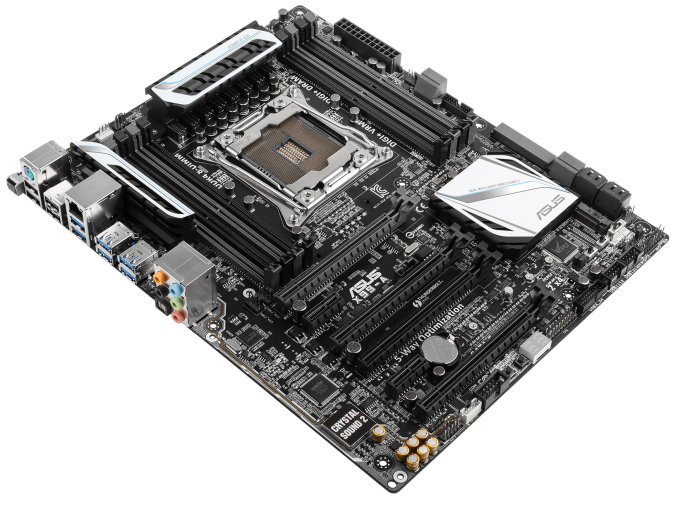ASUS X99-A Motherboard Review
by Ian Cutress on December 22, 2014 2:00 PM EST- Posted in
- Motherboards
- Intel
- Asus
- Haswell-E
- LGA2011-3
ASUS X99-A Conclusion
The term 'budget build' means many different things depending on who you speak to. For a HTPC user, it will involve a small motherboard with integrated graphics. For a gamer it might be an i3 paired with a graphics card that doesn't require extra power, such as an R7 240. For an X99 user, the term is not so clear cut because there is no truly budget board in this market. The chipset has a lot of IO to play with, which manufacturers add on the basis that when a user buys the chipset, they have essentially already paid for it. This means buying enough connectors for 10 SATA ports, PCIe storage, multiple GPUs and so on.
The end result is that 'budget' for X99 means under $300 for the motherboard, paired with a $390 i7-5820K and some DDR4. In that sub-$300 range each manufacturer has least a single model to aim at this crowd (some more than one), and for ASUS this is the X99-A.
Off the top, the X99-A brings in 10 SATA ports, 10 USB 3.0 ports (5 from the PCH, 3 from a hub and 2 from a controller), three-way PCIe via x16/x16/x8, an M.2 x4 running at PCIe Gen 3.0 and SATA Express. Add in to the mix an Intel I218-V network port, an upgraded ALC1150 audio solution via Crystal Sound 2 and an EZ XMP button for good measure. ASUS' strengths also lie in the BIOS and software packages, offering an easy to use system.
Looking at the performance numbers, the X99-A hits the midfield across most of the system benchmarks, excelling in our audio tests and being very reasonable for power consumption. The lack of MultiCore Turbo affects it at stock speeds but a quick switch to position one of the TPU gives a 3.9 GHz overclock, and makes this less of an issue.
For users going budget, the X99-A is worth a look, especially when it is on offer. But ultimately I think that the X99-A creates the contrast to the X99-Deluxe. By comparison, the X99-Deluxe comes with tri-stream 802.11ac Wi-Fi, dual M.2 x4 Gen 3.0 possibilities, and add in fan controller card, dual SATA Express, 10 rear USB 3.0 ports, a styled rear panel and audio design as well as more SATA ports, another NIC and better box contents. Is that worth the $125 difference? As a budget build, the X99-A could be paired with an i7-5820K but a user would still require almost $1000 for a full system. It is hard to say if the price difference to other motherboards is worth it, depending on what the user ultimately wants to integrate (M.2, WiFi) into their experience.











37 Comments
View All Comments
Aibohphobia - Monday, December 22, 2014 - link
Could you make more clear that while all the fan headers will power a PWM fan only the CPU headers actually function in PWM mode?You can look in the manual and see that all the Chassis headers are +5V on the fourth pin (100% duty cycle) and is using only voltage on the second pin for speed control. Of the Asus X99 boards only the Extreme has PWM control on all headers.
GeorgeH - Monday, December 22, 2014 - link
Asus is bragging about the "OC Socket" in their X99 motherboards, but so far it seems like snake oil. Any further comment beyond what was in the Deluxe review?Rajinder Gill - Monday, December 22, 2014 - link
The manual needs updating. Full PWM and DC control is offered on all CPU and chassis fan headers on the ASUS X99 series.-Raja
Aibohphobia - Monday, December 22, 2014 - link
I know both PWM and DC fans can be controlled, but is there an actual PWM signal on the 4th pin?The ROG Z97 boards were supposed to be full PWM control too but the Maximus VII Impact manual was updated in October and it still shows +5V on the 4th pin for the chassis headers as well.
vred - Monday, December 22, 2014 - link
Z97-WS can control PWM-fans using PWM signal, since I connect multiple fans to the same chassis header via the splitter which takes power from a Molex plug, and PWM signal from the motherboard, and RPM control works. I would assume X99 motherboards have the same functionality. Must be an error in the user manual.Rajinder Gill - Tuesday, December 23, 2014 - link
There is full pwm and dc mode on the headers - user selectable(it is a pwm signal on the pin when pwm mode is set for the header). The manual is wrong and needs correcting.Aibohphobia - Tuesday, December 23, 2014 - link
Awesome, that's great to hear. I got both a EVGA and Gigabyte X99 board recently and I was disappointed to find both had only PWM on the CPU header. I'll look forward to possibly switching back to Asus in the future.Grayfenix - Friday, January 9, 2015 - link
That is incorrect. All fan headers are capable of pwm. Switching back and forth in bios now.DanNeely - Monday, December 22, 2014 - link
What's with the Gigabyte board's horrible score in the 2nd Rightmark Audio test? There're a pair of **'s on the graphic implying a footnote explanation; but I can't find one.HollyDOL - Tuesday, December 23, 2014 - link
I would be interested in that too... it though seems like malfunctioned product judging by values presented.It would be also nice to see comparison with dedicated sound cards both synthetically and on ear test. I have yet to hear an integrated audio that doesn't sound terrible if you try to play it on a higher range amplifier (Hi-Fi/audiophile) and speakers (with appropriate cables). But that can hardly be evaluated objectively, we all hear a bit different.